
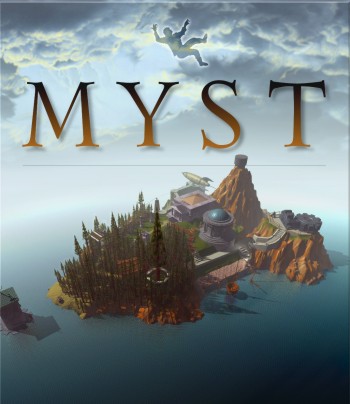
| Original Release Date | Publishers | Designers | Composers | Platforms | Storage Method | Game In Series |
| September 24, 1993 | Broderbund, Midway games (Re-release), Mean Hamster Software(re-release), Sunsoft (Re-release) | Rand and Robyn Miller | Robyn Miller | Mac, Windows, Saturn, PlayStation, Jaguar CD, Amiga OS, CD-i, 3DO, PSP (Re-release), Nintendo DS (Re-release) | CD-ROM | First |
| Original Technical Specifications for Windows | Processor | Operating System | Hard Drive Space | RAM | CD-ROM | Graphics | Sound |
| 386@33 MHz | Windows 3.1 or Windows 95 | 4 MB | 4 MB | 2x | 640x480, 256 Colors | Windows Compatible |
| Original Technical Specifications for Macintosh | Processor | Operating System | Hard Drive Space | RAM | CD-ROM | Graphics |
| 68020@16 MHz | Mac OS 7.0.1 or greater (OS 9.x or higher not supported) | 3 MB | 4 MB | 1x | 256 Colors |
The most well-known of the Myst games as well as the game
that started the craze, Myst changed the face of computer software
forever. Besides drawing more adults into video gaming and setting standards
that later games aspired to follow, Myst also helped usher in the
use of the CD-ROM drive, a then-new and relatively unused format that is now
used as the preferred medium of storing files, pictures, music, games, and
documents. Myst was a huge success, selling millions of copies and
becoming the best-selling game for years until The Sims exceeded
its sales in 2002.
 Myst
places you, the player (or as Myst fans would dub you, The Stranger), on a
strange and seemingly deserted island. The story goes that you somehow come
into the possession of an odd book, which you later learn is a special gateway
to another world called a linking book. The way you discover this is by accidentally
using it and linking to Myst Island! Unfortunately, the book’s only
a one-way trip, leaving you stranded. As you explore the island, you eventually
discover that something has gone wrong on Myst Island; a family quarrel between
a man named Atrus and his sons, Sirrus and Achenar, gone bad. The task is
now up to you to discover what exactly happened on Myst Island and figure
out whom you can trust – if you can trust anyone there at all.
Myst
places you, the player (or as Myst fans would dub you, The Stranger), on a
strange and seemingly deserted island. The story goes that you somehow come
into the possession of an odd book, which you later learn is a special gateway
to another world called a linking book. The way you discover this is by accidentally
using it and linking to Myst Island! Unfortunately, the book’s only
a one-way trip, leaving you stranded. As you explore the island, you eventually
discover that something has gone wrong on Myst Island; a family quarrel between
a man named Atrus and his sons, Sirrus and Achenar, gone bad. The task is
now up to you to discover what exactly happened on Myst Island and figure
out whom you can trust – if you can trust anyone there at all.
Characters
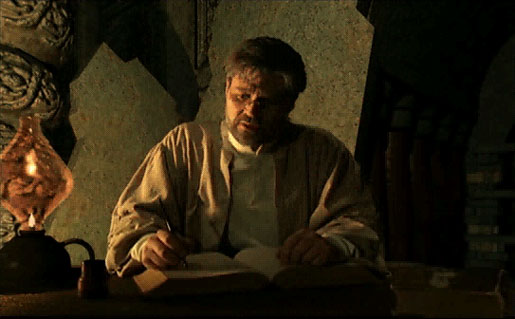 There
are only three characters in Myst barring you. The first, Atrus, is
a descendent of the ancient D’ni and knows how to write linking books
through a special art he learned from his father. Atrus is quiet, generally
kindly, and very scientific, but unfortunately a bit scatter-brained, preferring
to shelve a problem rather than face it. This last trait gets him into a lot
of trouble throughout the series and is generally the entire reason for the
plots of the games. Atrus was played by Rand Miller, who reprised the role in
the following four games.
There
are only three characters in Myst barring you. The first, Atrus, is
a descendent of the ancient D’ni and knows how to write linking books
through a special art he learned from his father. Atrus is quiet, generally
kindly, and very scientific, but unfortunately a bit scatter-brained, preferring
to shelve a problem rather than face it. This last trait gets him into a lot
of trouble throughout the series and is generally the entire reason for the
plots of the games. Atrus was played by Rand Miller, who reprised the role in
the following four games.
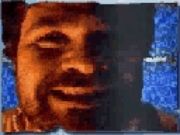
The Worlds of Myst
The original Myst has five worlds, called ages, in the game. There is also another age, Rime, which was created for and released with realMyst, a remake. The ages may be played in any order.
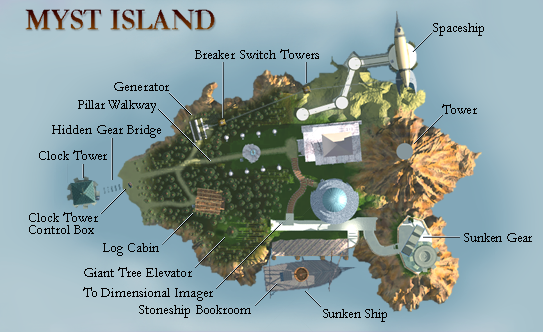 • Myst Island: The home age and starting point for the game. Myst Island is a strange world - a single island with all sorts of seemingly random buildings, such as marble pillars, a library, two enormous gears, a sunken ship, and a rocket ship, to name a few. The most prominent feature is a large mountain that holds a hidden tower, used to find the clues that will unlock the other four ages.
• Myst Island: The home age and starting point for the game. Myst Island is a strange world - a single island with all sorts of seemingly random buildings, such as marble pillars, a library, two enormous gears, a sunken ship, and a rocket ship, to name a few. The most prominent feature is a large mountain that holds a hidden tower, used to find the clues that will unlock the other four ages.
• Channelwood: A swampy forest age with three levels. The bottom level is much like a marsh walk with wooden platforms leading to a windmill. The second level is some sort of abandoned treetop village. The third level is Sirrus and Achenar’s private area, with bedrooms and what appears to be a small temple. The age is powered by water; to get around, you simply adjust a few of the controls on the lower level.
• Selenitic: This was once a very lush age, but decades of geological upset and a run-in with some meteors have turned it into a wasteland. The puzzles here are all based on sound, to the bane of some Myst fans.
• Stoneship: This age consists of a marooned ship stuck on a large rock. The most defining feature, aside from the rather large ship, is a lighthouse. The lower tunnels are flooded and lead to Sirrus and Achenar’s bedrooms. A lonely telescope sets at the top of the mountain-like rock the ship is stuck onto.
• Rime: Found only in a few re-releases of Myst, Rime is a bonus age and Easter Egg that the player can find and explore after beating the game. Rime is a bitterly cold age that is always snowing. There’s not a lot to see here save for Atrus and Catherine’s home-away-from-home and Atrus’ study.
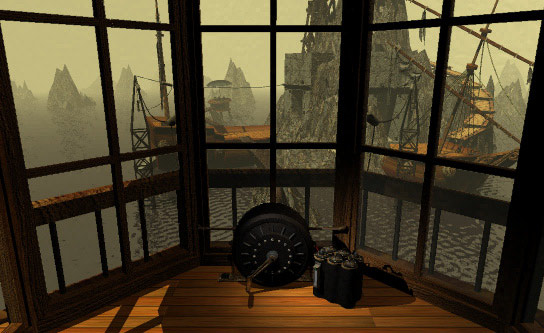
The concept for Myst was originally based upon an
unpublished story written by one of the Miller brothers called Dunny Hut.
The story involved the adventures of a young boy who discovers an underground
kingdom called, unsurprisingly, Dunny. He soon discovers that he is a long-lost
inhabitant of this underground world. This story was eventually recycled into
part of the plot of Myst, and the young boy became Atrus, whom the
player winds up helping out of several sticky spots throughout the series. The
two brothers in the game, Sirrus and Achenar, were originally supposed to be
a bit of a yin and yang duo – Achenar being the dark, evil brother, and
Sirrus being the good brother – and Atrus was really supposed to be dead.
But with the development of the plot, the Millers decided that Atrus should
be alive and that both the brothers should be the bad guys. This decision made
the player’s choice between the brothers much more difficult and much
more of a choice between the lesser of two evils.
The terrain proved to be the toughest aspect to create. The brothers had trouble
figuring out exactly how to map and render the various ages and their terrain
at first, but solved this issue by creating grayscale height maps and extruding
them to create elevation. The terrain, once finished, was later colored, textured,
and had buildings and trees added to it to finish the look. Because of the limited
capabilities of computers at the time, the brothers used texture to finish the
graphics, rendering even the smallest things, such as a screw in a metal plate,
by hand. This helped further enhance the realism that the game strove to portray.
The images were also compressed with Quicktime and stored in 8-bit color with
custom color palettes, so that the images loaded quickly and looked like true
color even though they had low color depth. Overall, Myst contains 2,500 pre-rendered
images, all modeled and created in StrataVision 3D for the Apple Macintosh and
polished in Photoshop 1.0 for the Apple Macintosh.
Myst was created on the Macintosh Quadra and was constructed in HyperCard,
a popular Macintosh-based programming tool at the time. Each age was a different
HyperCard ‘stack’, or set of data. The navigation for the game was
handled by HyperCard’s HyperTalk programming language. Because CD-ROM
drives were very slow at the time of Myst’s creation, Cyan really
had to work at making everything load quickly. All the movies were compressed
with Quicktime to make them run faster. In total, there is 66 minutes of film
in Myst.
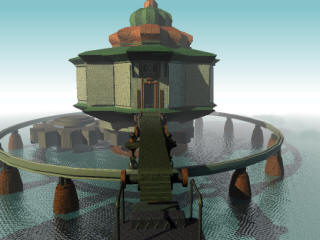 The audio for the game was another difficult task. The worlds of Myst
were obviously not real places, but each age had to sound real or else the player
wouldn’t be drawn into the game. The Miller brothers, along with Chris
Brandekamp, a friend of theirs, began their search for sounds, and found them
in some very unlikely places. Because some real-life things didn’t sound
real, the team had to find different options – for example, the sound
of fire in a boiler was created by driving over the gravel in the Miller brothers’
driveway. The sound of a large clock chime was made by striking a wrench and
transposing the resulting ring to a lower pitch. Even the sound of bubbling
water wasn’t left out – it was made by sticking a large tube into
a toilet and blowing into it!
The audio for the game was another difficult task. The worlds of Myst
were obviously not real places, but each age had to sound real or else the player
wouldn’t be drawn into the game. The Miller brothers, along with Chris
Brandekamp, a friend of theirs, began their search for sounds, and found them
in some very unlikely places. Because some real-life things didn’t sound
real, the team had to find different options – for example, the sound
of fire in a boiler was created by driving over the gravel in the Miller brothers’
driveway. The sound of a large clock chime was made by striking a wrench and
transposing the resulting ring to a lower pitch. Even the sound of bubbling
water wasn’t left out – it was made by sticking a large tube into
a toilet and blowing into it!
At first, the Millers wanted no sound or music in the game at all, fearing that
it would detract from the atmosphere, but after some extensive testing, they
discovered that the music didn’t interfere at all. In fact, it actually
seemed to help enhance the mood! The music was created by Robyn Miller, a then-aspiring
composer. Using a plug-in synthesizer and his Macintosh Quadra, Robyn composed
40 minutes of some of the most easily-recognized music in video gaming history.
Some tracks, like “Selenitic MystGate”, “Original Unfinale”,
and “Fireplace Theme”, weren’t used, mostly because they didn’t
fit with what the brothers wanted the game to be, were too dramatic, or weren’t
moody enough. These tracks, however, can still be found on the Official Myst
Soundtrack.
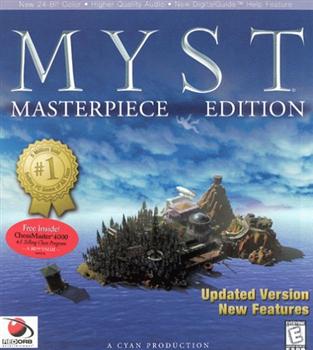
Myst was originally created for Macintosh, but the
Millers soon included versions for Windows, Sega Saturn, and PlayStation, to
name a few. The game was so successful upon its release, however, that it's
still being rereleased for today's computers and consoles! In May 2000, Cyan,
now Cyan Worlds, rereleased Myst as Myst Masterpiece Edition.
This updated version of Myst had rerendered all of the images in 24-bit
true color, as opposed to the original Myst’s 8-bit color, remastered
the musical score and sound effects, and redid some of the movies and animation.
It also added a built-in walkthrough and map system, in case a newer player
got lost. Myst fans enjoyed it at first, but soon found flaws – the music
was shortened at points, for one, and the game sometimes had problems on older
computers.
At this point, Cyan Worlds was experimenting with real time, and one of the
first things they tested it with was Myst. In November 2000, Cyan Worlds
rereleased Myst again, this time as realMyst: Interactive 3D Edition.
The game featured 3D graphics and a  free-roaming
world to explore instead of the pre-rendered stills of Myst and Myst
Masterpiece Edition. Effects such as changing weather, moving clouds, and
day and night changes were also added. The various ages also had minor tweaks
added to them, to keep up-to-date with the other sequels. As another bonus for
the fans, realMyst added another age, called Rime, as an extended ending.
Even though the fans loved the game and reviewers praised the new level of exploration
the game provided, realMyst ran very slowly on computers of the time,
and often refuses to run on Windows Vista.
free-roaming
world to explore instead of the pre-rendered stills of Myst and Myst
Masterpiece Edition. Effects such as changing weather, moving clouds, and
day and night changes were also added. The various ages also had minor tweaks
added to them, to keep up-to-date with the other sequels. As another bonus for
the fans, realMyst added another age, called Rime, as an extended ending.
Even though the fans loved the game and reviewers praised the new level of exploration
the game provided, realMyst ran very slowly on computers of the time,
and often refuses to run on Windows Vista.
In November 2005, Midway Games brought Myst back again, this time for
the PlayStation Portable. This remake would include Rime from realMyst plus
new, unseen content. The game was released in Japan and Europe in 2006 and only
recently released in the US. A version for the Nintendo DS was also released
recently. The sound and video was re-mastered using a programming language specific
to the DS and Rime was also featured as a playable age. Myst for the
Nintendo DS was released May 2008. Currently, Cyan Worlds is also working on
a version of Myst for the Apple iPhone, dubbed iMyst, in keeping
with the legacy of the Apple computer that put Myst on the map.
If you’re absolutely stuck and you need help with Myst, these walkthroughs can help you. I’ve provided two. The first is a low-spoiler walkthrough from Universal Hint System, useful to gradually help yourself through the game and the preferable way to go. The second is a full solution walkthrough. I do not recommend this one on your first time through – it just spoils the game for you, and if you love a good surprise as much as I do, then you’ll want to stay away from this one. Whichever you choose, I hope you find what you’re looking for and have fun playing Myst!